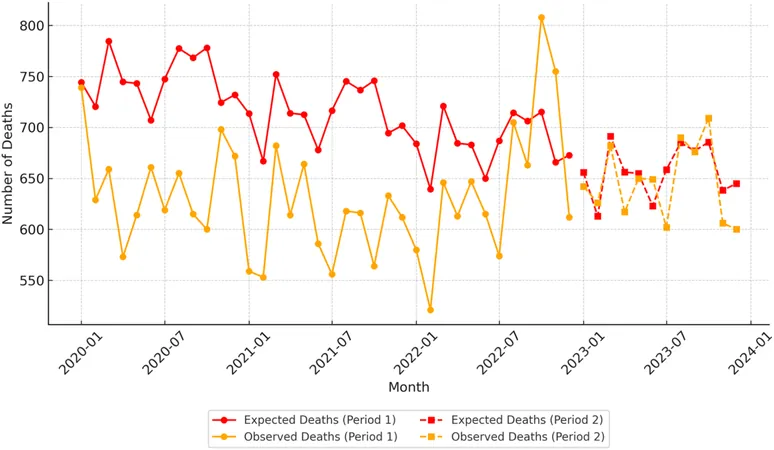
Alarming Rise in Child Mortality Rates in Thailand After Lifting COVID-19 Restrictions: What's Behind the Surge?
2025-01-20
Author: Wei Ling
Introduction
As the world grapples with understanding the full impact of the COVID-19 pandemic, a new study highlights a troubling trend in Thailand: a significant increase in child mortality rates following the discontinuation of strict COVID-19 policies. While the pandemic initially appeared to have a protective effect on child mortality, the subsequent lifting of restrictions has resulted in an alarming spike in deaths among children, raising questions about the underlying causes and future implications.
Study Overview
This comprehensive study examined all-cause mortality among children in Thailand from birth to age 15, utilizing data from the Thai Bureau of Registration Administration (BORA) collected over nearly a decade (January 2015 to December 2023). The research aimed to quantify excess mortality in the context of the pandemic, shedding light on the differences in mortality rates before, during, and after the COVID-19 policies were in place.
Key Findings
- **Total Deaths:** A staggering total of 81,510 child deaths were recorded during the study period, with males making up a notable 60.5% of these fatalities. Children under one year old appeared to be the most impacted group, accounting for 45.5% of all deaths.
- **Pandemic Impact:** During the pandemic, particularly from January 2020 to September 2022, the average monthly excess mortality declined. However, after the discontinuation of surveillance measures in October 2022, Thailand experienced a resurgence of excess mortality, with a P-score increase indicating a troubling trend.
- **Age Vulnerability:** The most significant rise in child mortality was observed among children aged 2 to 3, signaling the importance of focusing on this vulnerable group for future health interventions.
The Immunity Debt Phenomenon
One critical theory emerging from the study relates to "immunity debt." This concept posits that the strict public health measures taken during the pandemic reduced children's exposure to common pathogens, leading to lower levels of naturally acquired immunity. With the lifting of these restrictions, children now face increased susceptibility to infections, resulting in higher morbidity and mortality rates. Countries worldwide, including Thailand, are witnessing similar trends as they transition from stringent COVID-19 policies to living with the virus.
Healthcare System Strain
The increase in child mortality may also reflect the strain on Thailand's healthcare system. With hospitals reopening and services resuming, there could be a backlog of non-COVID-related health issues that were neglected during lockdowns. This backlog could worsen child mortality rates, as delays in diagnosing and treating childhood diseases may become evident.
Looking Ahead: The Need for Vigilance
As the research underscores, understanding the reasons behind the uptick in child deaths is paramount. Policymakers and public health officials must consider the implications of lifting COVID-19 restrictions on vulnerable populations and ensure robust healthcare systems are in place to avert future tragedies.
Conclusions
Thailand's experience serves as a cautionary tale for other nations. The abrupt end of pandemic-related measures has led to a disturbing rise in child mortality rates, suggesting that lifting restrictions needs to be handled with utmost caution. A multifaceted approach, focusing on both immediate healthcare needs and long-term infectious disease surveillance, is essential to safeguard the health of children in the post-pandemic world. Future studies should investigate the specific causes of this excess mortality and develop adaptive public health strategies to prevent similar crises in the future.
Stay tuned as we delve deeper into the implications of this study and its findings on child health in Thailand and beyond!



 Brasil (PT)
Brasil (PT)
 Canada (EN)
Canada (EN)
 Chile (ES)
Chile (ES)
 Česko (CS)
Česko (CS)
 대한민국 (KO)
대한민국 (KO)
 España (ES)
España (ES)
 France (FR)
France (FR)
 Hong Kong (EN)
Hong Kong (EN)
 Italia (IT)
Italia (IT)
 日本 (JA)
日本 (JA)
 Magyarország (HU)
Magyarország (HU)
 Norge (NO)
Norge (NO)
 Polska (PL)
Polska (PL)
 Schweiz (DE)
Schweiz (DE)
 Singapore (EN)
Singapore (EN)
 Sverige (SV)
Sverige (SV)
 Suomi (FI)
Suomi (FI)
 Türkiye (TR)
Türkiye (TR)
 الإمارات العربية المتحدة (AR)
الإمارات العربية المتحدة (AR)